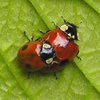Everyone likes ladybirds. From childhood we're familiar with these brightly-coloured beetles.
Less familiar to us are their eggs and their larvae, which could easily be mistaken for the offspring of a pest, rather than a friend. The eggs and larvae of the ladybird are pictured on this page. If you do find these strange-looking beasties in your garden, don't squash them! Ladybirds and their larvae are friends to the gardener and are very happy to eat all the aphids and whitefly.
Aphid population explosion
Every spring, the golden hop produces its beautiful fresh new leaves, and gets to the point when it's looking perfect, in May. Then very rapidly its leaves are covered in whitefly and aphids, hiding on the undersides of the leaves.
I don't use pesticides, and the plant is too big for me to tackle the problem by squashing the pests by hand. So the first year this happened I was rather annoyed, and thought I'd have to look at a sickly pest-covered golden hop all the summer long.
Help arrives
Alongside the aphids I could see weird-looking little black beasties (pictured right). These were ladybird larvae, and they soon cleaned up my golden hop plant.
The same thing seems to happen each year. This year, in the first week in June, I was struck by how many ladybirds there were on the golden hop - apparently far greater numbers. Everywhere I looked there were ladybirds in pairs, getting better acquainted.
The ladybird larvae were soon all over the plant, and small clusters of yellow ladybird eggs were still visible on the undersides of the hop's leaves, meaning, I guess, that more larvae would be hatching. All three stages of ladybird life were visible on this one plant: the eggs, the larvae, and the adult beetles. So it was a good thing that the hop plant had hosted so many pesky pests, or the ladybirds would have had nothing to eat.
They need your aphids!
Lack of available food has been a problem for ladybirds in some years. The BBC website Science and Nature section includes a useful page on the 7-spot ladybird. (The ones in my garden, pictured here, seem to be 2-spot ladybirds.) It says:
"In the summer of 1976 the ladybird population exploded in the UK.
Sadly, because there were so many, areas of southern and eastern England
were covered in millions of dead ladybirds who died of starvation when
their food supply ran out."
http://www.bbc.co.uk/nature/wildfacts/factfiles/412.shtml
Ladybird report from 1977 . . .
In case anyone is concerned about all those dead ladybirds in 1976, I can state that in the following year, 1977, there were plenty left, at least up here, in Yorkshire, in my parents' garden.
I've kept a few of my old school exercise books from the 1970s, the "Diary" the teacher asked us to write, every week, about our weekend and what we'd done. They're quite amusing, and include lots of not very good drawings. One entry features a ladybird happening - with a picture of ladybirds around the trees on my dad's rockery.
Twenty-seven years ago it seems that the highlight of my weekend was a lot of ladybirds emerging from a golden conifer. And here I am, older and supposed to be wiser, and still all excited by a sighting of ladybirds, this time on a golden hop. Thankfully, advances in technology in the intervening years mean I no longer have to draw them for you in coloured pencil.
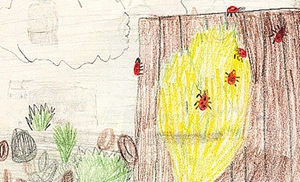
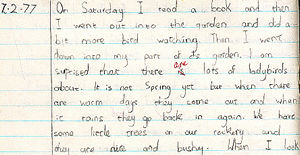
(Note teacher's correction to my terrible grammar.) The text reads: "I am surprised that there is [are] lots of ladybirds about. It is not Spring yet but when there are warm days they come out and when it rains they go back in again. We have some little trees on our rockery and they are nice and bushy. When I look at the top and I push one of the branches back there were lots of little ladybirds snuggled up together."
Interesting to note that this was written on 7 February that year, and the ladybirds were out early, as your young naturalist notes (!) Whether this was because global warming had already started, or because some annoying kid was poking around disturbing them from their hibernation, I'm not sure . . .
Variations
This year, in June, I also discovered an unusual yellow-coloured ladybird in the garden, which I'd not seen before. This, it seems, was a 14-spot type (pictured right). Further research revealed that there are many, many different kinds of ladybirds, with a range of spots and colouring.
There's an excellent factsheet on the HDRA site, which gives information on all the different kinds - see http://www.hdra.org.uk/factsheets/gg12.htm. For photos of ladybirds in all their variety see http://www.kendall-bioresearch.co.uk/beetle3.htm and the pages of the London and Essex Ladybird Surveys.
And finally . . .
This illustrated wander around the aphid-infested, ladybird-protected golden hop plant in my garden shows how nature is often so very clever and can find its own balance in our gardens. You can leave the aphid-killing chemicals in the cupboard, and if you're kind to the ladybirds they might do the hard work for you.
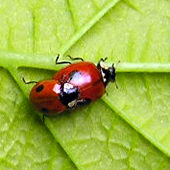
Above, below and top left: 2-spot ladybirds mating, on the golden hop plant, early June 2004.
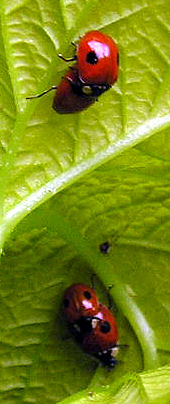
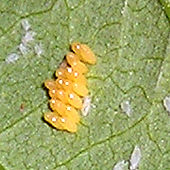
Above: yellow ladybird eggs, laid in a cluster on the underside of a leaf, close to whitefly and aphids
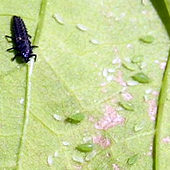
Above: ladybird larva approaches succulent aphids
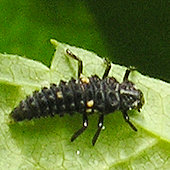
Above: ladybird larva. They might look a bit strange, but they're helpful to gardeners as an efficient predator of aphids.
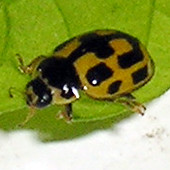
Above: A different kind of ladybird - the 14-spot variety

